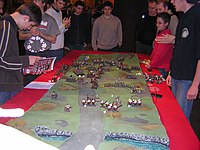
Photo from wikipedia
A multiscale fracture model is developed to study the influence of defects appearing at a microscale in a fiber-reinforced composite laminate. The model establishes a link between the geometrical characteristics… Click to show full abstract
A multiscale fracture model is developed to study the influence of defects appearing at a microscale in a fiber-reinforced composite laminate. The model establishes a link between the geometrical characteristics of sub-ply imperfections that may be created during manufacturing and the overall fracture strength and fracture energy of the composite. In particular, a recently-developed multiscale theory is expanded to account for microvoids inside the matrix and gaps between closely-spaced fibers that prevent filling. These defects are explicitly incorporated in finite element simulations to study their influence on the onset and propagation of cracks at the sub-ply level. To connect these microcracks to the effective fracture behavior at a ply-level, a computational homogenization technique is applied to extract the energetically-equivalent macroscopic fracture properties. Through a parametric analysis of configurations, the influence of the void content (porosity), void type and void shape on the effective fracture strength and the effective fracture energy of a composite are quantified. Results show that the porosity is the main parameter influencing fracture properties while the shape of the defects and their type (matrix or interfiber) only play a secondary role. Furthermore, the influence of voids on the fracture properties appears to be strongly dependent on the loading conditions. In particular, for the range of porosity analyzed (up to 8%), the influence of voids in mode I on the transverse fracture strength is not significant but the transverse fracture energy decreases approximately linearly down to about 50% of its original value. In contrast, in mode II, the transverse fracture strength is significantly affected with increasing porosity. Furthermore, the transverse fracture energy depends nonlinearly on the porosity and the reduction is relatively more pronounced than for mode I.
Journal Title: International Journal of Solids and Structures
Year Published: 2019
Link to full text (if available)
Share on Social Media: Sign Up to like & get
recommendations!